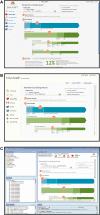The SMART Platform: early experience enabling substitutable applications for electronic health records
- PMID: 22427539
- PMCID: PMC3384120
- DOI: 10.1136/amiajnl-2011-000622
The SMART Platform: early experience enabling substitutable applications for electronic health records
Abstract
Objective: The Substitutable Medical Applications, Reusable Technologies (SMART) Platforms project seeks to develop a health information technology platform with substitutable applications (apps) constructed around core services. The authors believe this is a promising approach to driving down healthcare costs, supporting standards evolution, accommodating differences in care workflow, fostering competition in the market, and accelerating innovation.
Materials and methods: The Office of the National Coordinator for Health Information Technology, through the Strategic Health IT Advanced Research Projects (SHARP) Program, funds the project. The SMART team has focused on enabling the property of substitutability through an app programming interface leveraging web standards, presenting predictable data payloads, and abstracting away many details of enterprise health information technology systems. Containers--health information technology systems, such as electronic health records (EHR), personally controlled health records, and health information exchanges that use the SMART app programming interface or a portion of it--marshal data sources and present data simply, reliably, and consistently to apps.
Results: The SMART team has completed the first phase of the project (a) defining an app programming interface, (b) developing containers, and (c) producing a set of charter apps that showcase the system capabilities. A focal point of this phase was the SMART Apps Challenge, publicized by the White House, using http://www.challenge.gov website, and generating 15 app submissions with diverse functionality.
Conclusion: Key strategic decisions must be made about the most effective market for further disseminating SMART: existing market-leading EHR vendors, new entrants into the EHR market, or other stakeholders such as health information exchanges.
Conflict of interest statement
Figures





References
-
- Mandl KD, Kohane IS. No small change for the health information economy. N Engl J Med 2009;360:1278–81 - PubMed
-
- Office of the National Coordinator for Health Information Technology Strategic Health IT Advanced Research Projects (SHARP) Program. http://healthit.hhs.gov/portal/server.pt/community/healthit_hhs_gov__sha...
-
- U.S. National Library of Medicine 2011AA National Drug File—Reference Terminology Source Information. 2011. http://www.nlm.nih.gov/research/umls/sourcereleasedocs/current/NDFRT/
-
- U.S. National Library of Medicine SNOMED Clinical Terms (SNOMED CT). http://www.nlm.nih.gov/research/umls/Snomed/snomed_main.html
-
- U.S Food and Drug Adminstration National Drug Code Directory. http://www.fda.gov/Drugs/InformationOnDrugs/ucm142438.htm
Publication types
MeSH terms
Grants and funding
LinkOut - more resources
Full Text Sources
Medical

